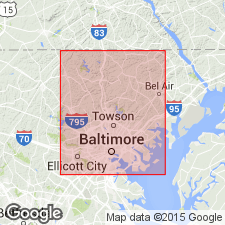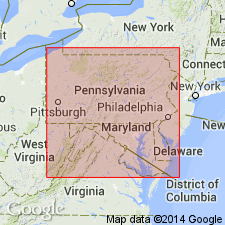
- Usage in publication:
-
- Piney Run Formation
- Modifications:
-
- Named
- Dominant lithology:
-
- Schist
- Quartzite
- AAPG geologic province:
-
- Piedmont-Blue Ridge province
Summary:
Piney Run Formation of Wissahickon Group is here named in Baltimore Co., north-central MD. Described as fine-grained, plagioclase-chlorite-muscovite-quartz schist interlayered with biotite quartzite. Locally has a seamed appearance due to closely-spaced thin veins and lenses of milky vein quartz. Thickness ranges to 2,100 m. Equivalent in part to the Peters Creek Formation. Overlies Lock Raven Schist (new) and underlies Sykesville Formation, both of Wissahickon Group. Age is Cambrian and Ordovician(?).
Source: GNU records (USGS DDS-6; Reston GNULEX).

- Usage in publication:
-
- Piney Run Formation
- Modifications:
-
- Revised
- AAPG geologic province:
-
- Piedmont-Blue Ridge province
Summary:
Use of the terms Wissahickon Group and Glenarm Supergroup, to which Piney Run formerly assigned, are discontinued in MD. Piney Run is here assigned to Liberty Complex on the basis of its correlation with the Morgan Run Formation.
Source: GNU records (USGS DDS-6; Reston GNULEX).
For more information, please contact Nancy Stamm, Geologic Names Committee Secretary.
Asterisk (*) indicates published by U.S. Geological Survey authors.
"No current usage" (†) implies that a name has been abandoned or has fallen into disuse. Former usage and, if known, replacement name given in parentheses ( ).
Slash (/) indicates name conflicts with nomenclatural guidelines (CSN, 1933; ACSN, 1961, 1970; NACSN, 1983, 2005, 2021). May be explained within brackets ([ ]).

